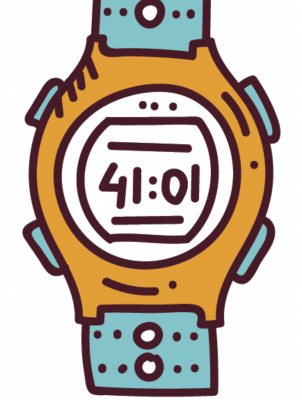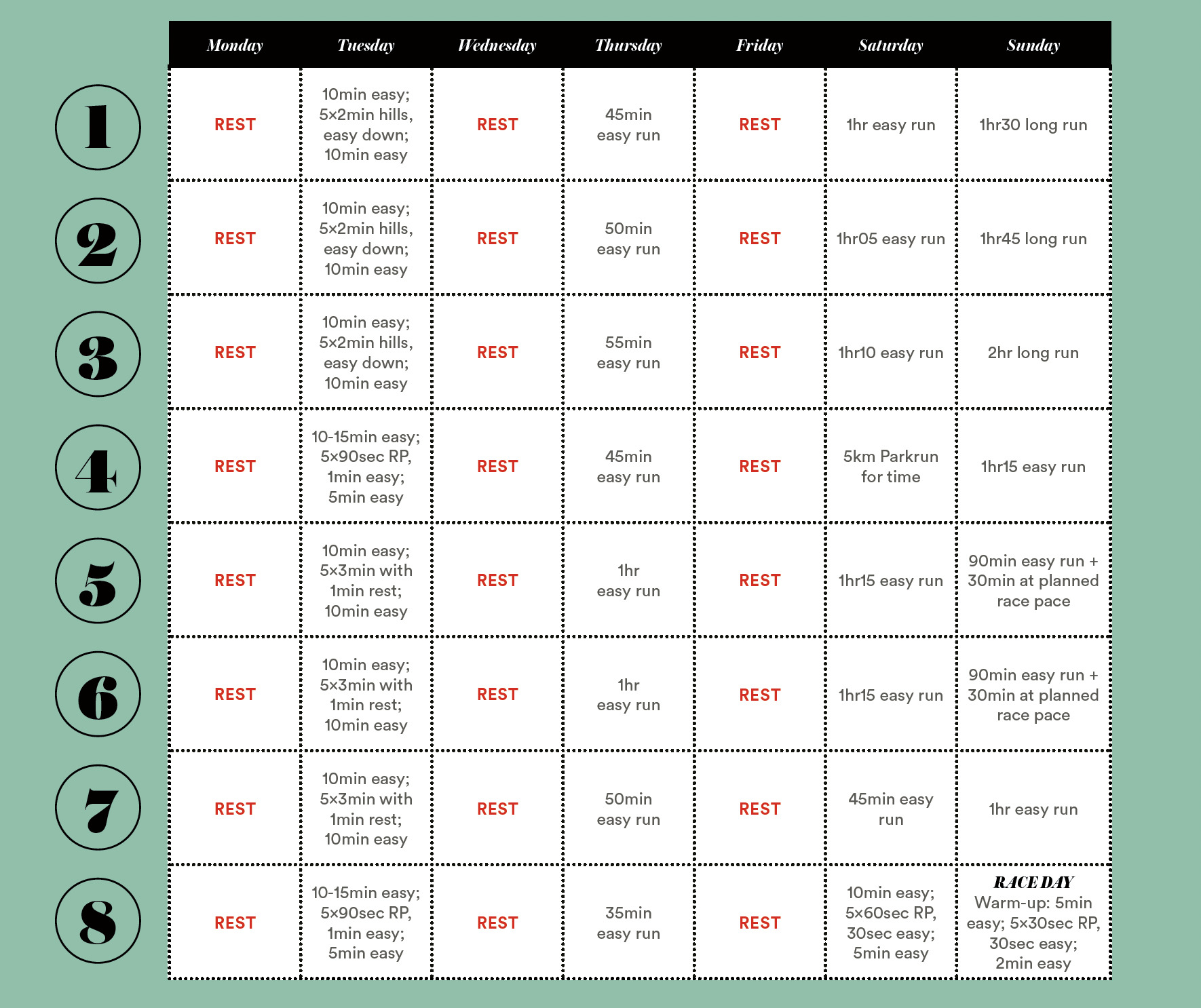11 Rules of Half-Marathon Running
Training for your first (or best) half marathon requires commitment – and a plan. The first bit is up to you, Lindsey Parry – aka Coach Parry – lays down the plan.
1. Set the Right Goal
Almost half the job is ensuring you set the correct target to train for. This should be based on something you’ve achieved in the recent past – be it a 5km parkrun, or a 10K, a 15, a half marathon or a marathon.
If you set the right target, you keep the training stimulus manageable, minimise injury risk, and – most importantly – give yourself every chance to improve over the six to eight weeks.
It’s critical that you’re clear about your expected race pace, since the entire training plan is based on that pace.

2. Train at the Right Pace
Whether it’s an interval session like hill repeats, three-minute intervals, an easy run or a long run, each running session should be designed with a particular outcome in mind. By basing these workouts on the ultimate achievable goal, you will constantly improve your physiology and physical requirements for achieving your goal.
In the early weeks of our eight-week training plan, the interval sessions may be slightly out of reach. What’s important is that you can maintain your pace from the first rep to the last. If you’re slowing as the set progresses, start next week a little more conservatively. If you’re hitting the paces in the final weeks, you know you’re on track.
3. Consistency
Performing well on race day is about preparing well. What you do day to day and week to week will have a bigger impact than anything else on how your race day goes. This includes training at the right pace, doing the right workouts, and achieving the goal outcomes of these workouts.
You can only be disciplined and consistent if you allow your body to absorb the training, and recover well. That’s a why I like the four-day running week so much: if each workout is done well, you will improve immensely while you rest or recover on off days.
4. Hills are Important
In my view, this is one of the most critical training blocks.
We can use hills to lay the strength foundation for speed work to come, and importantly, to work on running form.
Also, when we run uphill, we have a natural tendency to lean forward slightly and use our arms to build momentum. These are cornerstones of great running technique; and simply by adding in a focus to remain tall and not hunch over when you get tired, you take care of three very important components of good running form.

5. Develop a Winning Mindset
You’ve set your goal, and have a plan to follow. Time to bury the excuses and look for reasons why you can, rather than why you can’t.
The elites may be looking for ways to win, but the reality is that we’re no different; just like them, we can only do the best we can do on race day. A ‘winning’ mindset is making sure you can take care of what you can control: training, nutrition, recovery, goal setting, session execution, and race plan and execution.
It’s not about being perfect all the time – that’s not your job. It’s about, for a few weeks, mostly getting it right. Building confidence through your actions, and walking the talk in training.
6. Work on your Nutrition and Hydration
In general, most of the field will not have enough stored energy to get through a hard half marathon. On top of that, it’s not wise to rely entirely on what’s on the water tables during the race.
A common mistake runners make is to practise all their nutrition on long runs. This is great for fuelling long runs, and for finding products that you like. However, drinking water and/or taking in fuel from gels and jellies and so on is vastly different at easy run pace vs race pace.
At race pace you’re breathing deeply, and a missed breath while swallowing can take you by surprise. Often a gel that you love in training suddenly becomes very hard to get down in a race.
You have two opportunities to try your nutrition, during the race-pace finish sessions. I also like to get runners to try taking in nutrition during their intervals, so that they’re used to it on race day.
Fortunately, for a half marathon you don’t need loads of consistent nutrition; often, just a few sips of the energy drink on offer at the water tables, or a gel, will be enough. However, you do need to practise with the available products.
Hydration is the same: while you don’t need to take in fluids at every stop, on a hot day you may want to aim for 50-100ml every 20-30min.
7. Get There Early
This should fall under planning, but it’s such an important element of getting it right on the day that it needs its own special mention. You’ll be nervous enough on race day without stressing about – or worse, being late for – the start.
Make sure your car’s parked at least an hour before the start. When the nerves kick in, you’ll need a loo; and because you’re not a unique physiological specimen, you’ll note that you’re not alone.
In turn, getting ablutions done early will leave you with time to limber up and do a short warm-up. Warming up is important no matter what your time goal is, so that you can get on pace quickly. When we’re cold and tight, it’s much harder to ‘feel’ the right pace – often leading us to struggle to get into the groove from the get-go.
If you get into the start chute with time to spare, you can also spend your time thinking through the process, focusing on what your pace and effort will be through certain sections. Seeing the race unfold helps you get through it the way you’ve planned and imagined.
8. Smile
Your face is connected to your neck, your neck to your shoulders and back. It’s hard to tense your shoulders when you’re smiling. Tension in the shoulders and back causes you to hunch, which rolls your arms forward and shortens your stride. So there’s a real, biomechanical reason to smile!
Smiling relaxes the neck, which helps us be more upright. A relaxed neck helps keep the shoulders relaxed, allowing your arms to swing forward and back. Since your right arm works in tandem with your left leg – and vice versa – being upright, open and relaxed leads to larger and more powerful strides, at lower energy cost.
9. Setting Up Your Race Plan
As you move into the final weeks, it’s important to take your race goal a step further, and turn it into a race plan. You don’t want to spend weeks preparing for a race, and then end up winging it on race day. This will almost certainly ensure you start out too fast. Your race plan must cover your pace; when and what nutrition you will take; and how you will execute.
Pacing Plan
It’s important to find out what the route profile of the race is – how many turns, how many hills and how steep, and where they all are.
In a race, you want to maintain as even an effort as possible; and on a hilly route, that won’t allow for an even pace. Depending on gradient and length, you’ll look to go 20-45secs/km slower on the ups, and 15-30 secs/km faster on the downs. This is ultimately why hilly routes tend to be slower than flat routes; you can’t really make up all the lost time from hills. And if you try too hard to minimise lost time – and/or catch it up – you’ll be left with tired legs in the last third.
This is exactly why we always aim to start strong, but finish stronger. If you plan the pacing right and respect the hills, you’ll finish very strong. Often a strong finish makes you feel as if you’ve left time on the road; but in reality, it probably means you got your pacing spot on.
Defending when you’re too tired is much harder than chasing when you feel good.
Adjust For a Fast Start
Start at – or close to – the required pace for your goal, especially if it’s a flattish start. You’ll be too fast through the first kilometre; to finish strong, it’s critical that you adjust and avoid doing another one too fast.
This will help you set the tone for effort, and help you to adjust for pace on the climbs and the downs.
Nutrition
Don’t forget to plan your race-day nutrition. Not just what you’re going to use on the route (and when), but what you’ll take before your race (and when). If you do this well, you can sometimes plan on having no nutrition during the race.
We all respond differently to eating during a race. Some are too nervous to eat, some just can’t stomach food early, etc etc. Figure out what you can take, and how much. And then experiment during training with different foods, and go with the one that’s easiest to digest.
10. Know Success
Running hard for 21.1km is mentally taxing; and often, failure on race day is linked to an inability to just keep pushing through the discomfort.
I like to have at least two good reasons – that I can read, on my hands or forearms – about why I’m doing this. It could be your kids, for positive role modelling; showing work colleagues what’s possible; a burning, lifelong goal to break a barrier over 21.1km; an inspirational quote; or all of Liverpool’s six Champions League trophies. Anything that really puffs your chest, makes you determined, and helps you push to the line.

11. This Is The Last Race
If a race is important, I convince myself that no other performance will ever matter again. It’s only about today. If I’m unable to compete again because of this effort, so be it; but today, I am giving everything of myself that I can, mentally and physically.
Coach Parry’s 8-Week Training Plan
Training Paces
Race Pace (RP): Half-marathon pace
Easy: RP + 45-90sec
Long: RP + 50-100sec
Recovery: RP + 1:40 – 2:00min
Hills: RP – 15-30sec
3min: RP – 30-45sec

READ MORE ON: 8 week training plan half-marathon training plan two-oceans-half-marathon



